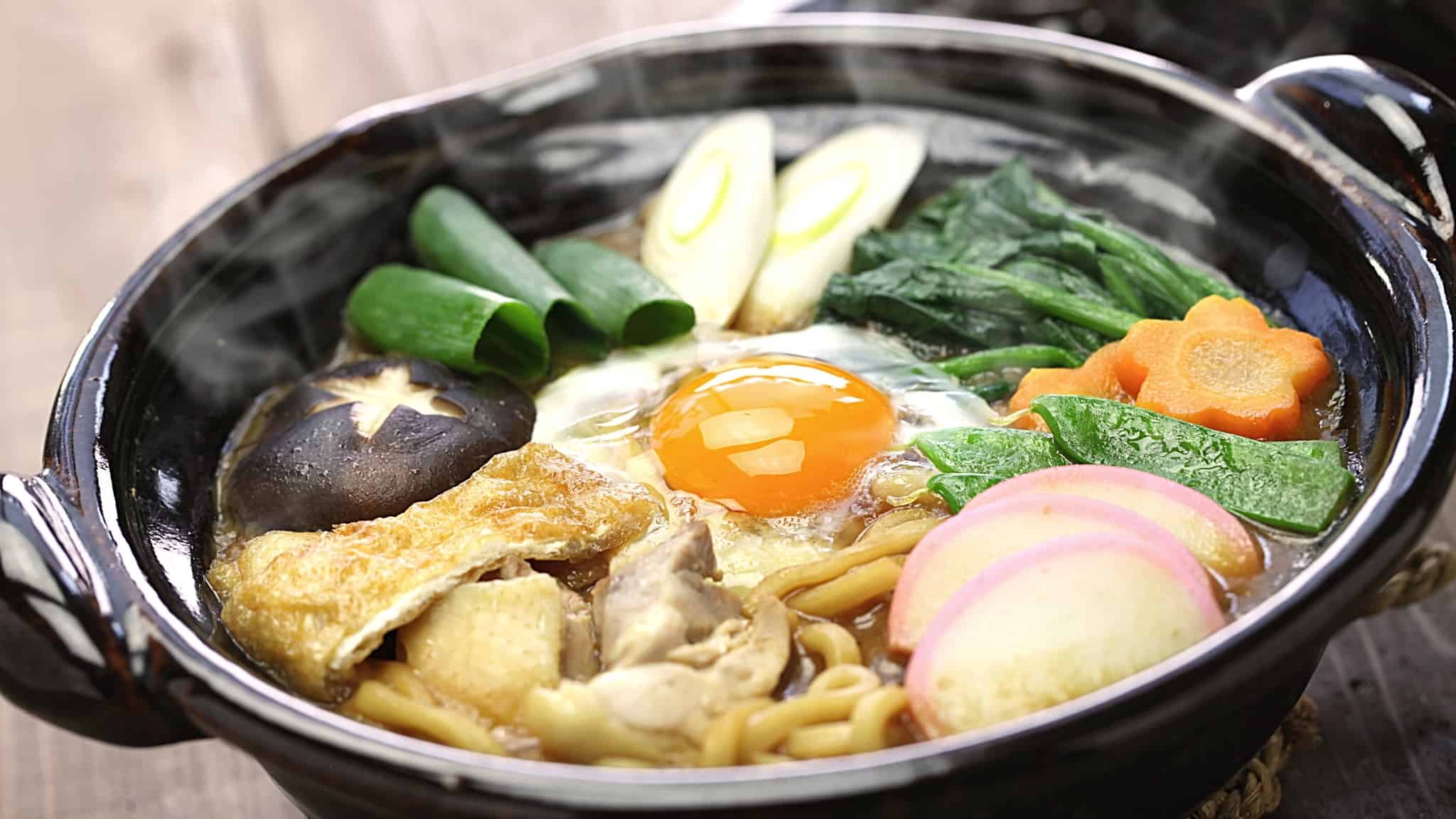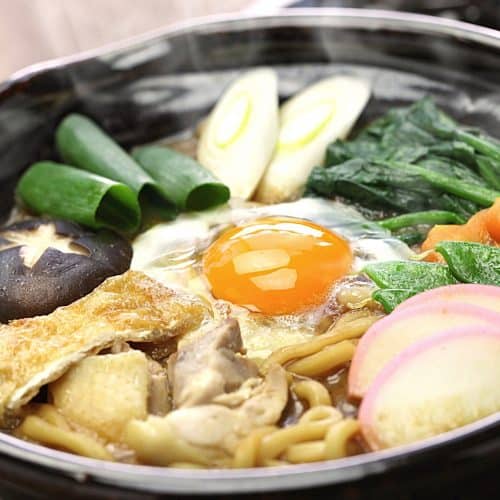Miso nikomi udon recipe | The perfect hearty and savory Japanese noodle soup
If you’re looking for a delicious soup recipe that warms you from the inside out, you have to try miso nikomi udon.
This miso nikomi udon recipe is a noodle soup made by simmering chicken, fish cake, and udon noodles in a miso-dashi broth. I’ll show you my favorite way of making it hearty and savory using some shichimi togarashi spice.
If you’re looking to include miso nikomi udon in your weekly rotation, I’ll show you some great ideas for preparing it.

It is native to the Nagoya region of Japan where Hatcho miso is quite popular.

Check out our new cookbook
Bitemybun's family recipes with complete meal planner and recipe guide.
Try it out for free with Kindle Unlimited:
Read for freeIn this post we'll cover:
Miso nikomi udon ingredients
We’ll get to the miso nikomi udon recipe in a minute, but let’s start by talking about the variety of ingredients you can use.
Udon noodles
Udon noodles are one of the ingredients that you really can’t substitute. After all, what’s miso nikomi udon without the udon?
You can buy udon noodles in the store, but you can elevate your dish by making them at home.
They contain three simple ingredients, flour, water, and salt. So if you’re skilled at making Japanese noodles yourself, it might not be too hard.
Dashi
Dashi is a Japanese broth and another ingredient you won’t want to be without. However, there are several types of dashi you can use to change things up a bit.
Kombu dashi, for instance, is vegan and if you use it, you will end up with a completely vegan-friendly dish.
You can also use katsuo dashi that’s made from katsuobushi and dried and fermented bonito.
Awase dashi is another choice. It contains kombu and katsuo.
Protein
Commonly used proteins include chicken and egg.
However, if you’re vegetarian, you might want to substitute with veggies like mushrooms and tofu. Leeks, green onions, and scallions will add to the taste.
Fish cake
The Japanese fish cake that’s used in the soup can be hard to find. Feel free to substitute it with Chinese and Korean varieties.
Also read: these are Jakoten Japanese fish cakes
Miso
Miso is another integral ingredient in miso nikomi udon.
The soup is typically made with Mame Miso which is 100% soybean miso. This is the best type of miso to use in the soup because it won’t lose a lot of flavor when it simmers.
But you are welcome to experiment to find the option you prefer.

Miso nikomi udon recipe
Ingredients
- 3 cups dashi
- 4 shiitake mushrooms approx. 2.3 oz.
- ½ package shimeji mushrooms approx. 1.8 oz
- 1 negi long green onion- approx. 4 oz.
- 1/3 kamaboko fish cake
- 2 servings udon noodles approx. 6.3 oz.
- 1 piece aburaage deep fried tofu pouch
- 2 large eggs
- 1 chicken thigh approx. 7 oz.
- Shichimi togarashi Japanese seven spice
- 3 tbsp. mirin
- 4 tbsp. miso
Instructions
- Prepare the dashi to make three cups. This can be done in a variety of ways but for simplicity’s sake, we suggest using a dashi packet in water.
- Cut the end of the shimeji mushrooms and chop into chunks.
- Cut the stems off the shiitake mushrooms and cut in half.
- Cut the fish cake into four slices.
- Cut the negi at a diagonal angle and separate the green and white pieces.
- Pour hot water over the aburaage to reduce the oily coating if desired.
- Cut the chicken into bite sized pieces.
- Boil a pot of water and add udon noodles, loosening them with chopsticks. Once they are loosened (about 30 seconds) drain them into a colander and set aside. (If you use dry noodles, prepare according to package directions).
- Crack eggs into a small bowl.
- Add chicken, dashi and white part of negi to a large pot or donabe.
- Cover and cook on medium heat for 10 minutes. The outside of the chicken will no longer be pink although the inside may still be pink.
- Then turn heat to a simmer and use a skimmer to remove the fat and scum.
- Add 3 tbsp and 3 tbsp. miso keeping one tbsp. for later. Place miso in a ladle and use chopsticks to help dissolve it before releasing it into the dashi. This will ensure that no miso chunks are left in the recipe.
- Add udon noodles, all mushrooms, aburaage and the green part of the negi.
- Turn up heat to medium, cover and cook for five minutes. Once boiling, turn down the heat to simmer. Check on the dish every so often using chopsticks to make sure no ingredients are sticking to the bottom of the pot. Remove fat and scum with a skimmer.
- Use a ladle to drop the remaining 1 tbsp of miso in the soup. The ladle will prevent you from losing the miso.
- Add fish cakes and drop eggs carefully into the middle. Cook uncovered 2-3 minutes.
- Serve at the table in the pot with individual bowls for serving. Sprinkle with shichimi togarashi to add a hint of spice.

Vegetarian miso nikomi udon recipe
Ingredients
- 1 red chili
- 3 cm of ginger ½ grated and ½ finely chopped
- 1 tbsp. tamari
- 1 tbsp. sesame
- 3 cloves garlic
- 120 g udon noodles
- 200 g mixed mushrooms
- 800 ml boiled water
- 1 tbsp. white mushroom
- 1 grated carrot
- 1 lime
- 1 tbsp. sesame seeds
- 3 spring onions
Instructions
- Mix sesame oil and tamari in a deep pan and heat on medium. Then add finely chopped garlic and ginger. Fry for 3 minutes.
- Fry garlic for 2 additional minutes.
- Add mushrooms. Fry on high for 6 minutes.
- Add water, miso paste and noodles. Heat for three additional minutes.
- Garnish with grated carrot, a squeeze of lime, sesame seeds and finely chopped onions.
Notes
- The finely chopped ginger will be added to the sesame and tamari mix while the grated portion may be added to the stock.
- Fry the mushrooms in garlic, chili, and ginger on medium-high heat. This will get them nice and crispy. Then set aside a spoonful to place them on top of the soup before serving.
- Add miso at the end of the recipe to help retain the flavor.
- Adding extra lime will provide a great accent of flavor for the miso.
- Blanch the carrot in the soup after adding it to the top for 1 to 2 minutes. This will soften it slightly to get a congruous texture.
What can I serve with miso nikomi udon?
Because miso nikomi udon is so hearty, it is typically served as a main course. However, if you are having a smaller portion, you may eat it with any of the following items.
A sandwich
Soup and sandwich make a terrific combo. Since you are eating a Japanese-style soup, why not pair it with a Japanese-style sandwich?
Here are some ideas:
- Japanese egg sandwich: This egg and mayo sandwich is a great variation on the classic egg salad.
- Japanese fruit sandwich: This unusual recipe calls for seasonal fruits embedded into whip cream served on white milky bread. (hé, why don’t I see fruit that often in Japanese dishes?)
- Katsuo sando: Crispy pork filets on white milky bread… yes please.
- Wanpaku sandwich: Making this sandwich requires layering vegetables and other ingredients. It’s a great way to make use of leftovers.
- Chicken katsu sandwich: This fried chicken sandwich will taste perfect with tomato, lettuce, cucumber and garlic sauce.
- Menchi katsu sandwich: This sandwich starts with a fried meat cutlet. Thinly shredded cabbage and tartar sauce are added to provide the perfect flavoring.
- Spam onigirazu: This Hawaiian classic consists of spam, fried eggs and sweet sushi rice wrapped in a crunchy nori wrap.
- Teriyaki salmon onigirazu: Onigirazu is a Japanese rice sandwich. This one uses teriyaki salmon to add to the heartiness.
- Bulgogi onigirazu: This onigirazu variation uses Korean grilled meat, vegetables, eggs and nori. Add gochujang sauce to make it truly delicious.
- Ginger pork onigirazu: Thin slices of pork, a hint of ginger and layers of rice and nori make this sandwich a treat.
Also check this shogayaki ginger pork recipe for an easy dinner
Poultry options
Another option is to serve the soup with a poultry filet. Here are some to consider:
- Chicken katsu: This is a boneless chicken breast flavored with panko breadcrumbs.
- Wagyu filet mignon: Filet mignon is always delicious, but the Wagyu variety has less marbling that makes it more tender and flavorful.
- Teriyaki salmon: Salmon is a light and healthy main course option. The teriyaki will make it taste authentic. Here’s a good teriyaki salmon recipe.
What is the origin of miso nikomi udon?
Miso nikomi udon originated in the Nagoya region of Japan but it is enjoyed all around the country.
Different types of miso are used in accordance with what’s popular in the region.
How is miso nikomi udon served?
The soup is typically served in an earthenware pot called a donabe. I have a cookbook dedicated to the donabe in my top 23 best Japanese cookbooks.
A donabe is a great cooking utensil for liquids that require slow and low cooking. It holds heat exceptionally well.
The donabe is brought to the table so guests can extract their soup portions.
If you don’t have a donabe, another type of pot can be used instead. Just make sure it is big enough to hold all the ingredients. This will depend on how much soup you are looking to make.
Miso nikomi udon is terrific for providing warmth and comfort on a cold winter’s day.
With so much potential to change up the recipe, you can serve it time and time again and never get bored. Which of these preparations do you prefer?
Also read: Japanese Soups | Soup culture and the different kinds of soups
Check out our new cookbook
Bitemybun's family recipes with complete meal planner and recipe guide.
Try it out for free with Kindle Unlimited:
Read for freeJoost Nusselder, the founder of Bite My Bun is a content marketer, dad and loves trying out new food with Japanese food at the heart of his passion, and together with his team he's been creating in-depth blog articles since 2016 to help loyal readers with recipes and cooking tips.

